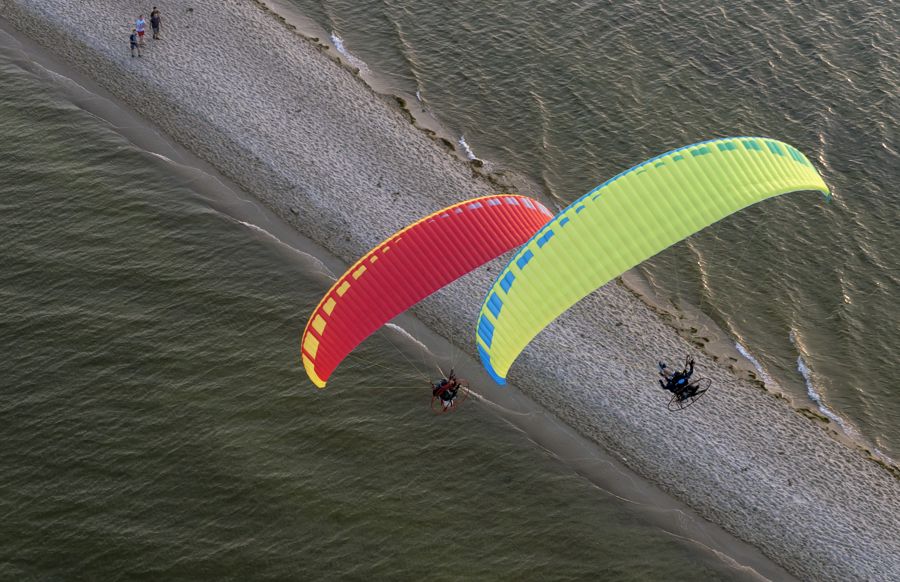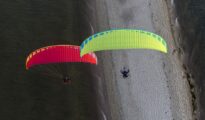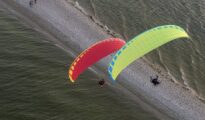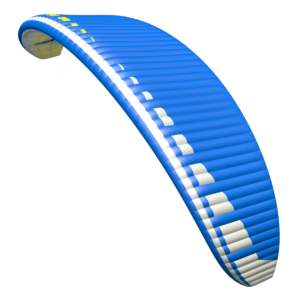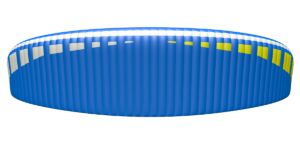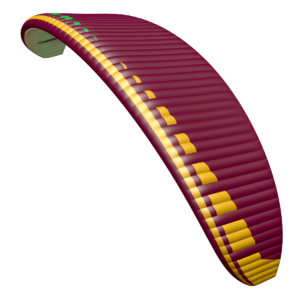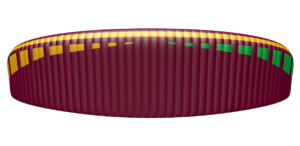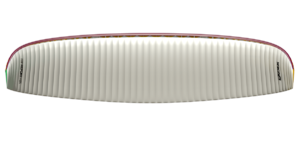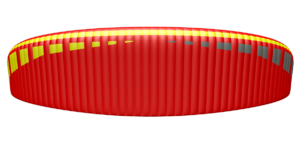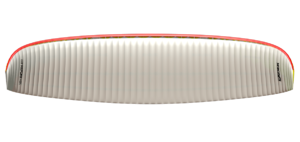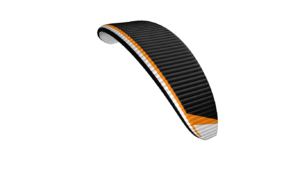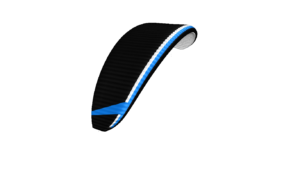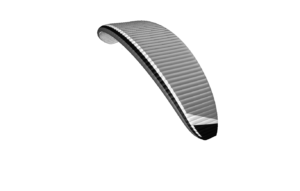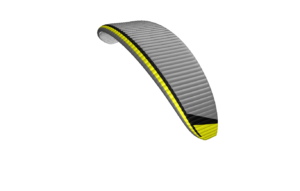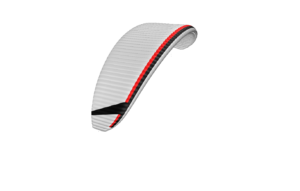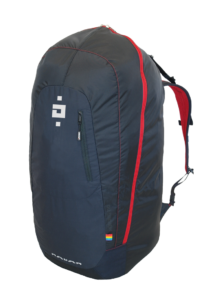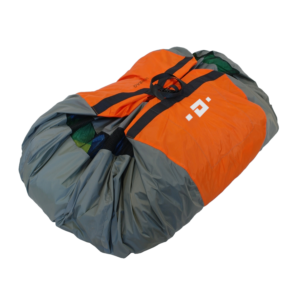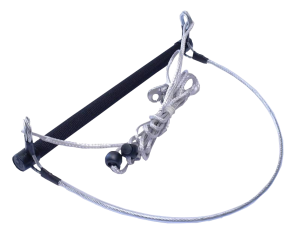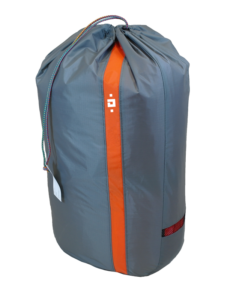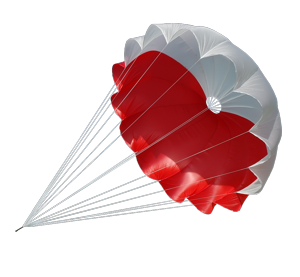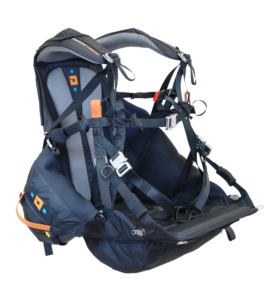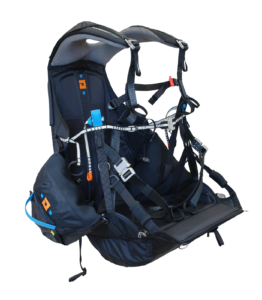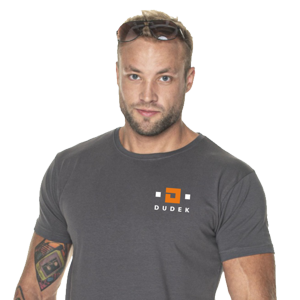Reportair
Reportair
It looks like the evolutionary path of reflex paragliders is about to complete a circle. Reportair is the next avatar in a line originated by Traper, Action and Reaction, continued through Nucleon and Nucleon WRC, finishing in the Nucleon XX. This time we focused on the legendary feature of the first designs - the uncompromised stability.
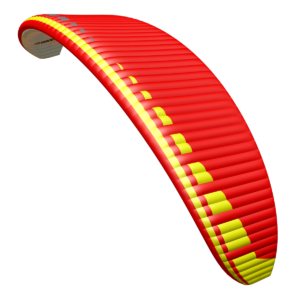
Design and purpose
There are many pilots who praise our continuous improvements, resulting in even smoother fusion of reflex stability with better agility, easier launch and more speed. All of the Nucleons have that.
However, there are also many pilots who miss the legendary, uncompromised stability of the first reflex wings. Those are mainly professionals, needing to let free of the brakes and get busy with their real work in the air. The list includes photographers, patrol services, search and rescue groups, filmmakers, military, forest guards, reporters, travelers, scientists, road management… theres no ending. Last but not least – there are regular pilots who want to indulge in pure, stress-free sightseeing.
 See movie
See movie
Accordingly, in the Reportair weve focused on recreating that legendary stability, so when flying it you can literally feel the peace and trust it radiates. The paraglider moves as if on tracks. Simultaneously weve put a lot of effort into polishing launch – now its sure and easy to perform both in nil wind, when even lifting the canopy can be hard, and in strong wind, when losing the bearings can be hard to compensate. The speed at released trimmers is very good, too – comparable to the Nucleon XX.
Striving for perfection, weve invited one of the best flying photograpers, Kacer Kowalski, (multiple winner of the World Press Photo with his paraglider-based photos) to collaborate with us. Kacper presented us with a list of features an ideal task-oriented canopy should have, then tested several protos in various weather. His remarks had great impact on the final Reportair prototype.
 See movie
See movie
Our collaboration was not limited to technicalities only. When he saw the four elements colour design prepared for the Reportair, Kacper – being an architect by professional training and artist pilot by temperament – convinced us to prepare a limited Ko-Ka version too, 10 unique collector canopies. The KoKa colour scheme is inspired by recent Kacper fascinations with constructivism. Each of the KoKa wings has its individual colours and is sold at a special price, with €1000 directed to a charity goal: Polish Humanitarian Action. Only size 26 is available.
Construction solutions
Technologies, concepts
Risers functionality
Used solutions
Parameters
Weight ranges

TECHNICAL DATA
| Report’air – size | 22 | 24 | 26 | 28 |
| Approval – ULM identification | yes | yes | yes | yes |
| Cell number | 60 | |||
| Surface flat [m2] | 22.00 | 24.00 | 26.00 | 28.00 |
| Surface projected [m2] | 18.97 | 20.69 | 22.42 | 24.14 |
| Wingspan flat [m] | 11.10 | 11.59 | 12.07 | 12.52 |
| Wingspan projected [m] | 8.88 | 9.28 | 9.66 | 10.02 |
| Apect ratio flat | 5,60 | |||
| Apect ratio projected | 4,16 | |||
| Sink rate [m/s] | min = 1.2 (+/- 0.2 m/s) | |||
| Speed* [km/h] | min = 26 ; trim = 38-50 ; max = 64 (+/- 3 km/h)* | |||
| Longest chord [mm] | 2454 | 2563 | 2668 | 2769 |
| Shortest chord [mm] | 603 | 630 | 656 | 681 |
| Suspension length [m] | 6.88 | 7.19 | 7.48 | 7.77 |
| Total lines length [m] | 305.03 | 319.07 | 332.54 | 345.5 |
| Total take-off weight** [kg] | 85-120** | 95-130** | 105-145** | 115-160** |
| Distance betwen risers [cm] | 45 | 45 | 45 | 45 |
| Canopy weight [kg] | 5.8 | 6.2 | 6.5 | 6.9 |
| Lines | Edelrid A-8000U: 050 / Liros TSL: 090 & 140 & 190 & 280 & 380 | |||
| Cloth | Porcher Sport 38 g/m2, Dominico tex 34 g/m2, Porcher Sport Hard 40 g/m2, SR Scrim, SR Laminate 180 g/m2 | |||
* Speeds are given as estimated for the middle wing size and the middle of its weight range. These speeds can vary within +/- 3 km / h depending on the size, take-off weight and additional factors such as air pressure and temperature.
** The basic rule is to choose the size of the wing so that the take-off weight is in the middle of the weight range. Less weight on the wing (lower range take-off weight) can be considered for foot take-off, when flying in calmer conditions, or when we want to improve economy. More experienced pilots who want to fly dynamically, have higher speed and fly in more demanding wind conditions can consider greater wing loading (take-off weight in the upper range). This is a common option among trike users.
Note – the canopy significantly changes its behavior with increasing wing loading. The greater the loads, the greater skill and concentration of the pilot are required.




